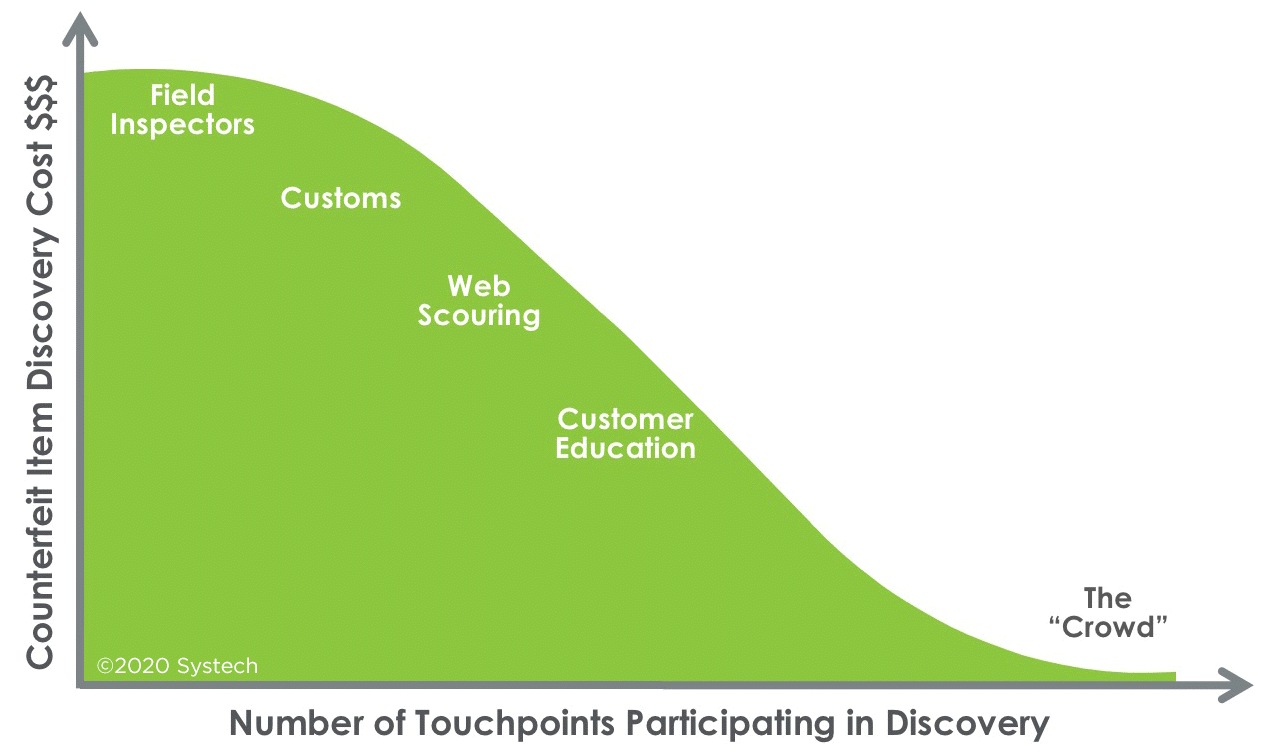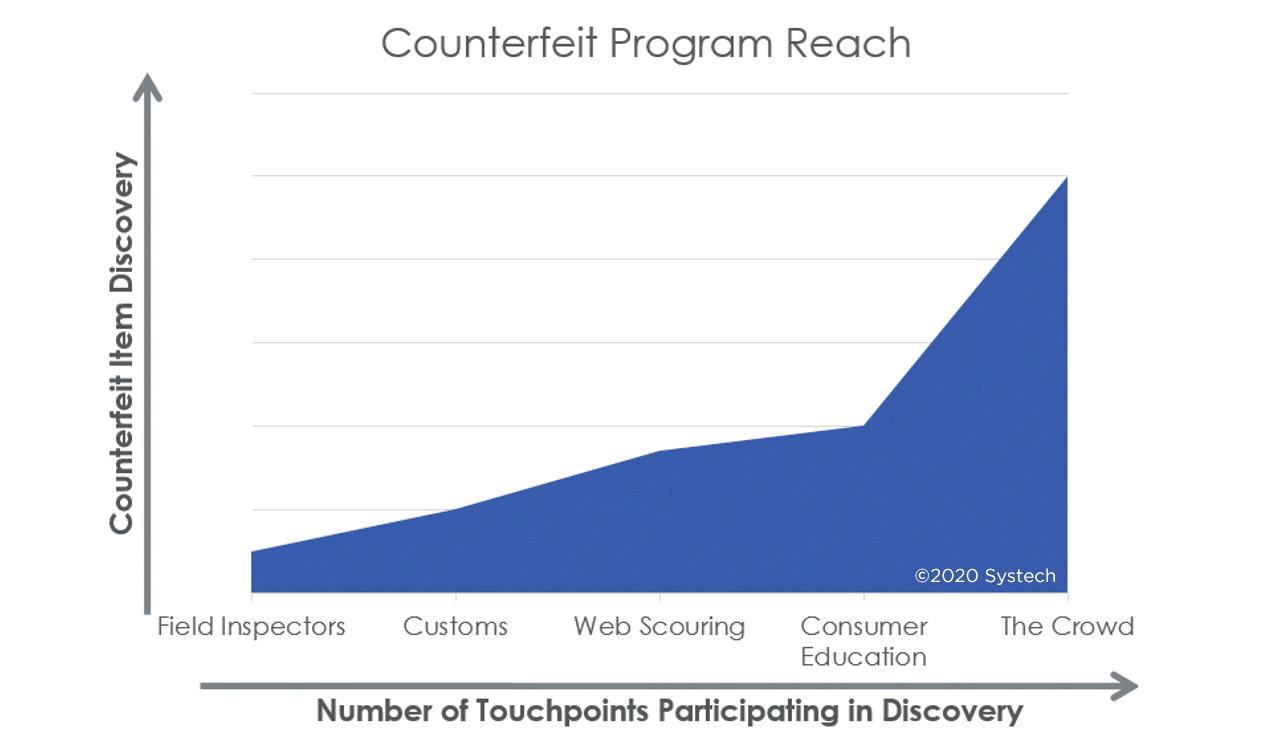
Fact: If a product is popular, it will be counterfeited. Finding those counterfeits is critical to getting them off the market and protecting your customers. What if you could scale a counterfeit discovery program to your entire customer base—at maximum “crowdsourced” impact for minimal cost? And once this type of program is established, the data-enriched benefits you and your consumers will receive are limitless. Let’s explore this concept.
Counterfeiting is a huge issue for brands and is, by any measure, only getting worse. Despite the initiatives manufacturers are putting in place to protect their products, counterfeiters are still winning. The fakes aren’t going away. According to the Organisation for Economic Co-operation and Development (OECD), an international non-profit organization that works to build better policies for better lives, commerce in fake and pirated goods is now 3.3% of world trade and rising. This means a staggering $500 billion grey market, which impacts every geography across the globe.
Essentially, if your product is successful, you’ve got a problem. A BIG problem!
The landscape has changed
There was a time when it was possible to discern a fake product from a genuine one just by examining the package. Certain external characteristics/flaws—like a misspelled word or a flimsy material—would give it away. Now, printing and imaging technology has evolved and become so inexpensive that counterfeiters can easily obtain it to create packaging that fools even the savviest consumer.
Additionally, in the past counterfeiters had to penetrate legitimate supply chains to get their fake products in stores or sell in quasi-legitimate marketplaces. Neither were simple endeavors, and most brand’s internal resources were sufficient for discovery of a critical mass of fakes. Their own feet on the street could solve much of the problem.
Today, global e-commerce platforms have transformed the storefront. Virtual “stores” that look and act the same as legitimate enterprises selling the real thing can easily be set up to look completely authentic while selling counterfeit merchandise. With online sales growing rapidly year over year, the opportunities have never been greater for counterfeiters. The ease at which counterfeit-peddling stores can open, be discovered and closed, then reopened under a different name on these same platforms is systemic.
Profit from Pandemic
Now, add an unprecedented global pandemic to the mix and you have an ideal scenario for counterfeiting. These bad actors simply see COVID-19 as a business opportunity. Systech has already blogged about fake coronavirus tests being a counterfeiters dream and counterfeit PPE threatening our frontline healthcare workers. One commonality in these situations is that entities were using e-commerce platforms for buying and selling.
Online sales in June 2020 were up 76% year over year compared with June 2019. This is certainly not surprising given the current environment. People are consumers and there is always the need to shop—even when restricted to the safety of our homes. And as the world begins to reopen, many brick and mortar retail outlets have either closed or reduced visitor capacity. Add to that the sensitivity around mask wearing in public spaces, and it is easy to understand why many consumers have simply decided to go all-digital for purchases.
The rise in consumer use of these online marketplaces significantly increases the risks and uncertainty for brands. It is no longer possible to grow a product business regionally, nationally then internationally and have brand protection efforts expand along with market presence. Instead, with the international scope of e-commerce platforms, once a business exposes itself to the benefits of placing products online—which creates a geographic scope far greater than limited brand protection efforts can handle—it begins to face a significant global counterfeiting threat.
What’s a brand to do?
Brands need more “feet on the street” to do the necessary discovery, and associated heat mapping, of fakes in traditional and online marketplaces. We are seeing a trend toward increasing the number of touchpoints across the supply chain, in order to discover more counterfeit products sooner and reduce program cost. Traditional methods of employing field inspectors, partnering with customs and implementing web scouring resources are essential, but only go so far. Our borders are big, and the Internet is expansive. Fakes will get through the gaps. LOTS of fakes.

Figure 1: Conceptual representation of what’s possible: When more people are looking, the cost per counterfeit found will decrease
Proactively educating consumers about counterfeit products and identification techniques is crucial. Many luxury brands have websites and registries designed to highlight and differentiate counterfeits from legitimate product. Some brands have introduced feedback pages where consumers can submit examples of counterfeits they’ve found.
A priority for consumer education programs is definitely the identification process but should also focus on “why” counterfeiting is bad. First and foremost is customer safety, of course. Illicit medicines, cosmetics, car parts, baby products and other items can hurt or even kill unsuspecting users. Second, and less thought about, is that counterfeiting is crime that funds bad organizations who do more harm globally.
Education initiatives highlight the issue for consumers and expand the reach of a discovery effort. But not every consumer is made aware of these efforts. Education is only one part of the program to identify and take fakes off the market.
Enter crowdsourcing…
Putting the power of counterfeit detection into the hands of as many individuals as possible is key to significantly impact and hyper-escalate the discovery of fake products. What if you could equip each and every customer to be a field agent for your counterfeit detection and brand protection program? What if you could connect each and every one of your product packages to the digital world with a unique identity that can be verified authentic—and can’t be duplicated? What if your package already has a feature to allow this to happen RIGHT NOW? Would you consider it?
The answer starts with finding a way to connect the previously unconnected package to the connected world—the Internet of Things (IoT). To link consumers to brands through their products. Here’s how: The vast number of products in the market have a point-of-sale (POC) barcode, typically a universal product code (UPC) code. There are solutions available that can derive unique identifiers from these package barcodes that can be used for product authentication. With this technology, not only can you authenticate the item, but it’s possible to individually identify each and every product uniquely.
Take Systech’s e-Fingerprint® technology as an example. This solution leverages a standard printed barcode and the ubiquity of smartphones to enable anyone, anywhere to instantly authenticate a product and connect with the brand. The non-additive nature of the technology also represents a substantial cost saving on capital purchase, artwork redesign and change management when compared to additive solutions like RFID tags.
Now, each and every customer can authenticate items globally, providing instant feedback to the brand via a simple smartphone app. And once crowdsourced authentication gains traction, there are amazing analytics to be had. Virtual heat maps can be built through automated reporting tools. Brands will know where the problems are at the speed of consumer behavior. Supply chain gaps can be addressed. Not just more rapidly, but with global location precision never before possible at this scale. Brands will also see where and when authentic products are being engaged with for instant insight into where these programs are working—and where they aren’t yet.

Figure 2: Conceptual representation of what’s possible: When more people are looking, more counterfeits will be found
Crowdsourcing is an opportunity to make a gigantic leap in your counterfeit discovery program. Consumers will get value from knowing they have legitimate product (or not), and you get advanced data directly from your customers. Both are gaining value, a necessary component to make crowdsourcing work.
Make crowdsourcing work for you, fight the fakes together with your consumers!

Steve Tallant is Senior Director, Market Development, Systech
©
SecuringIndustry.com







